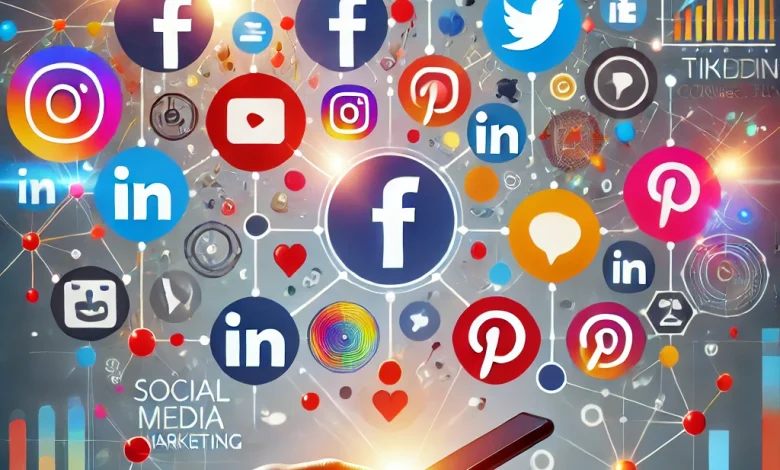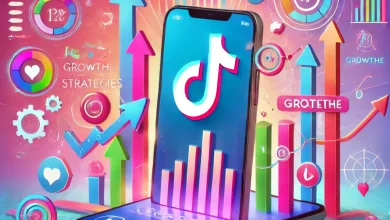Social Media Marketing: 10 Key Strategies for Success and Future Trends

Table of Contents
1. Introduction
Definition of Social Media Marketing
Social media marketing is a form of digital marketing that leverages social media platforms to promote brands, engage with audiences, and drive business goals. This dynamic strategy utilizes various forms of content, paid advertising, and analytics to build an online presence.
Importance in Today’s Digital World
In today’s digital-first era, social media marketing has become an indispensable tool for businesses. With billions of users active on platforms like Facebook, Instagram, and TikTok, it provides unparalleled access to target audiences. Whether it’s boosting brand visibility, generating leads, or fostering customer relationships, social media marketing is at the heart of modern business strategies.
Overview of Its Evolution
The journey of social media marketing began with platforms like MySpace and Friendster in the early 2000s. Over time, platforms like Facebook, Twitter, and Instagram emerged as dominant players. Today, the landscape is more diverse, incorporating everything from short-form video content on TikTok to professional networking on LinkedIn.
2. Key Platforms for Social Media Marketing
Facebook
As one of the largest platforms with over 2.9 billion monthly active users, Facebook is a cornerstone of social media marketing. It offers robust advertising tools, audience segmentation, and content formats like posts, stories, and groups.
Instagram
Instagram focuses on visual content, making it ideal for brands in fashion, food, and lifestyle. With features like Stories, Reels, and Shoppable posts, it blends creativity with commerce.
Twitter (X)
Twitter, now rebranded as X, excels in real-time updates and customer interactions. Brands use it for announcements, customer service, and building thought leadership through concise and impactful posts.
LinkedIn
LinkedIn is the go-to platform for B2B marketing. It facilitates professional networking, thought leadership, and targeted advertising to decision-makers and professionals.
TikTok
With its viral short-form video format, TikTok has revolutionized how brands connect with Gen Z and millennials. Creative campaigns and challenges thrive here.
Pinterest
A visual discovery platform, Pinterest is perfect for brands in design, home decor, and DIY niches. Its focus on aspirational content makes it a top choice for product inspiration and lead generation.
3. Benefits of Social Media Marketing
Increased Brand Awareness
With billions of active users, social media platforms amplify brand visibility. Engaging posts, shares, and mentions increase a brand’s reach exponentially.
Better Customer Engagement
Social media fosters direct communication between brands and customers. Features like comments, polls, and live chats enable meaningful interactions.
Cost-Effective Advertising
Social media ads often cost less than traditional advertising, delivering targeted results with measurable ROI. Platforms like Facebook and Instagram allow businesses to start with minimal budgets.
Improved Website Traffic
By sharing links and running campaigns, social media drives significant traffic to business websites, boosting SEO and sales.
Higher Conversion Rates
Trust and authenticity built through social media translate into higher conversion rates. User-generated content and reviews further influence purchase decisions.
4. Essential Strategies for Effective Social Media Marketing
Setting Clear Goals and Objectives
Define measurable goals like increasing followers, generating leads, or boosting engagement to align your efforts with business objectives.
Knowing Your Target Audience
Understanding your audience’s demographics, interests, and online behavior ensures that your content resonates and drives results.
Creating Engaging Content
Compelling content, from witty captions to high-quality visuals, is key to capturing audience attention and fostering engagement.
Utilizing Visuals and Storytelling
Visuals and storytelling create emotional connections. Infographics, behind-the-scenes glimpses, and user stories humanize brands.
Consistency in Posting and Engagement
A regular posting schedule paired with active engagement keeps your brand relevant and top-of-mind.
Leveraging Influencer Marketing
Partnering with influencers helps brands tap into established communities and enhance credibility.
Running Paid Ad Campaigns
Social media platforms offer advanced ad targeting options, ensuring that your campaigns reach the right audience with precision.
5. Types of Social Media Marketing Content
Organic Posts vs. Paid Promotions
Organic posts build community and foster engagement, while paid promotions boost reach and target specific audience segments.
Video Content
Videos, from tutorials to product demos, capture attention more effectively than static posts. Platforms like YouTube and TikTok are pivotal for video strategies.
User-Generated Content (UGC)
UGC, such as customer reviews or unboxing videos, adds authenticity and trust to your brand narrative.
Live Streaming
Live videos on platforms like Facebook and Instagram create real-time connections, fostering transparency and immediate interaction.
Interactive Content (Polls, Quizzes, Contests)
Interactive content boosts engagement by encouraging audience participation, making your brand more relatable and approachable.
6. Tools for Social Media Marketing Success
Content Scheduling Tools
Platforms like Buffer and Hootsuite simplify content planning and ensure consistent posting across multiple channels.
Analytics and Tracking Tools
Tools like Google Analytics and Sprout Social provide insights into performance metrics, helping marketers refine strategies.
Design Tools
Visual content creation is streamlined with tools like Canva and Adobe Spark, enabling non-designers to produce professional-quality graphics.
7. Challenges in Social Media Marketing
Algorithm Changes and Platform Updates
Frequent algorithm changes impact content visibility, requiring marketers to stay agile and adaptive.
Managing Negative Feedback and Crisis Handling
Responding to criticism with transparency and professionalism is crucial to maintaining brand reputation.
Staying Ahead of Competitors
With new trends emerging daily, staying innovative and relevant is a constant challenge.
Measuring ROI Effectively
Accurately attributing revenue to social media efforts can be complex, necessitating advanced analytics and tracking methods.
8. Future Trends in Social Media Marketing
1. AI and Automation
Artificial intelligence (AI) is transforming social media marketing by enhancing efficiency, personalization, and user engagement. AI-powered tools, such as chatbots and virtual assistants, are streamlining customer service by offering instant responses, addressing queries, and even processing transactions. Content generation tools powered by AI help marketers create blog posts, social media captions, and video scripts in seconds, reducing manual effort.
Predictive analytics, another AI-driven advancement, enables businesses to analyze user behavior, preferences, and interactions to forecast future trends. This allows brands to optimize their content strategy, ad targeting, and customer journey personalization. Additionally, AI-driven sentiment analysis tools help brands monitor online conversations, gauge audience sentiment, and respond appropriately to maintain their reputation.
AI also powers visual recognition technology, which allows brands to analyze images and videos for insights into consumer preferences. With AI-driven automation, businesses can schedule posts, analyze performance metrics, and adjust their strategies in real time. As AI continues to evolve, its integration with social media marketing will become more sophisticated, offering even more precise targeting and efficiency.
2. Rise of Short-Form Content
Short-form content has become a dominant force in social media marketing, driven by platforms like TikTok, Instagram Reels, and YouTube Shorts. These bite-sized, highly engaging videos cater to shrinking attention spans and provide a quick, entertaining way to consume content. Brands are increasingly leveraging short-form content to capture audience interest, convey messages concisely, and drive engagement.
Short-form videos are effective because they are visually appealing, easy to share, and align with mobile-first consumption habits. Creative storytelling, catchy music, and interactive elements like challenges and duets make this format highly engaging.
Additionally, platforms are optimizing algorithms to prioritize short-form content, further increasing its visibility and organic reach. Brands that incorporate short, engaging videos into their marketing strategies can foster stronger connections with their audiences, increase brand recall, and encourage user participation through trends and challenges.
Looking ahead, short-form content is expected to evolve with more interactive features, augmented reality (AR) integrations, and shoppable elements that directly link to products, making it a crucial element of future marketing strategies.
3. Personalization and Hyper-Targeting
Personalization is becoming a cornerstone of social media marketing, with consumers expecting tailored experiences based on their interests and behavior. Hyper-targeting leverages advanced data analytics and AI to segment audiences more precisely than ever before.
Social media platforms collect vast amounts of user data, including browsing habits, purchase history, and engagement patterns. Brands can use this data to deliver highly relevant content, recommendations, and ads that resonate with individual users. Hyper-targeting enables marketers to create customized messaging for specific demographics, ensuring higher engagement and conversion rates.
Moreover, dynamic content, such as personalized email campaigns and retargeting ads, allows brands to nurture leads effectively. Social media platforms like Facebook and Instagram offer retargeting options that remind users of previously viewed products, increasing the likelihood of conversions.
Consumers are more likely to engage with brands that deliver content relevant to their needs, making hyper-targeting essential for customer retention and loyalty. The future of personalization in social media marketing includes the use of AI to predict user preferences, create individualized experiences, and enhance customer journeys across multiple touchpoints.
4. Integration with E-Commerce
The integration of social media and e-commerce, known as social commerce, is revolutionizing the way consumers discover and purchase products. Platforms like Instagram Shops, Facebook Marketplace, and TikTok Shop provide seamless shopping experiences, allowing users to browse and buy without leaving the app.
Social commerce leverages features such as shoppable posts, live shopping events, and product tags to make the buying process more interactive and convenient. Brands can showcase their products through engaging visual content, influencer collaborations, and user-generated content, building trust and encouraging purchases.
Live shopping events, where influencers and brands showcase products in real time, have gained significant traction. Consumers can ask questions, see product demonstrations, and make purchases instantly, creating an immersive shopping experience.
Another emerging trend is the integration of augmented reality (AR) in social commerce. AR allows users to try on products virtually, such as clothing, makeup, or home decor, providing a more personalized and engaging shopping experience.
With advancements in payment gateways and security, social commerce is expected to grow further, making social media platforms an essential sales channel for businesses of all sizes. Brands that embrace social commerce can benefit from higher conversion rates, increased brand visibility, and improved customer satisfaction.
5. Growth of Influencer and Micro-Influencer Marketing
Influencer marketing continues to thrive as brands collaborate with influencers to reach target audiences authentically. However, a shift is occurring towards micro-influencers—individuals with smaller but highly engaged followings. Micro-influencers offer higher levels of trust, relatability, and niche authority, making them valuable for targeted marketing campaigns.
Brands are focusing on long-term partnerships with influencers to build credibility and foster authentic relationships with their audience. Additionally, influencer-generated content often outperforms traditional brand content in terms of engagement and trust.
The rise of AI-driven influencer marketing platforms allows brands to identify the right influencers based on data-driven insights, ensuring more effective collaborations. As social media platforms introduce features to support influencer marketing, such as creator marketplaces and monetization options, this trend is expected to continue growing.
6. Expansion of Augmented Reality (AR) and Virtual Reality (VR)
Augmented reality (AR) and virtual reality (VR) are transforming social media marketing by offering immersive and interactive experiences. Platforms like Snapchat and Instagram have already integrated AR filters, allowing users to try products virtually, enhancing engagement and purchase decisions.
Brands are leveraging AR to create unique experiences, such as virtual showrooms, interactive ads, and gamified content. As AR technology becomes more accessible, it is expected to play a more prominent role in social media marketing strategies.
Virtual reality (VR) is also gaining traction, enabling brands to offer virtual tours, product demonstrations, and interactive storytelling experiences. As the metaverse concept grows, VR is likely to become an integral part of social media marketing, providing new opportunities for brand engagement and interaction.
7. Emphasis on Social Responsibility and Authenticity
Consumers are increasingly prioritizing brands that align with their values and demonstrate social responsibility. Social media platforms provide a space for brands to communicate their commitment to sustainability, inclusivity, and ethical practices.
Authenticity is key to building trust, and brands that share behind-the-scenes content, employee stories, and community initiatives resonate more with audiences. Social media users expect transparency and genuine interactions, making it essential for brands to stay authentic and socially responsible in their marketing efforts.
Conclusion
Social media marketing has evolved into a powerful tool that businesses of all sizes can leverage to build brand awareness, foster customer relationships, and drive sales. By utilizing platforms such as Facebook, Instagram, LinkedIn, and TikTok, companies can reach their target audiences with precision and engage them through compelling content and personalized interactions.
As trends continue to shift, businesses must stay agile and adapt to changes such as AI-driven automation, short-form content popularity, and social commerce integration. Embracing innovative strategies while maintaining authenticity and social responsibility will be key to long-term success.
With the right approach—combining organic content, paid promotions, and data-driven insights—social media marketing can provide a competitive edge in the digital landscape. Whether it’s through influencer collaborations, interactive storytelling, or community engagement, businesses that harness the full potential of social media will continue to thrive in the ever-evolving digital marketplace.
Frequently Asked Questions (FAQs)
Q1: What is social media marketing, and why is it important?
Social media marketing is a digital strategy that utilizes social media platforms to promote products, engage with audiences, and achieve business goals. It is important because it helps businesses increase brand awareness, generate leads, and foster customer relationships in a cost-effective manner.
Q2: Which social media platform is best for my business?
The best platform depends on your target audience and business goals. Facebook and Instagram are ideal for B2C businesses, LinkedIn works best for B2B marketing, and TikTok is perfect for brands targeting younger audiences with engaging video content.
Q3: How can I measure the success of my social media marketing efforts?
Success can be measured using key performance indicators (KPIs) such as engagement rates, website traffic, conversion rates, and return on investment (ROI). Analytics tools like Google Analytics, Facebook Insights, and Hootsuite provide valuable performance data.
Q4: How often should I post on social media?
Posting frequency varies by platform, but consistency is crucial. For instance, posting daily on Instagram and Twitter, and 2-3 times a week on LinkedIn, helps maintain audience engagement without overwhelming them.
Q5: What type of content performs best on social media?
Video content, user-generated content, and interactive formats such as polls and contests tend to perform best. Content that provides value, entertains, and encourages interaction resonates more with audiences.
Q6: How can businesses handle negative comments on social media?
Businesses should respond to negative comments professionally and promptly. Addressing concerns with transparency, offering solutions, and maintaining a positive tone helps preserve brand reputation and build trust.
Q7: What are some emerging trends in social media marketing?
Emerging trends include AI-powered automation, short-form video dominance, hyper-personalization, social commerce, influencer marketing, and the integration of augmented reality (AR) and virtual reality (VR) experiences.
Q8: Is paid advertising necessary for social media success?
While organic content builds long-term relationships, paid advertising is crucial for reaching larger audiences, driving immediate conversions, and achieving specific marketing objectives efficiently.
Q9: How do I choose the right influencers for my brand?
Select influencers based on their audience demographics, engagement rates, and authenticity. Micro-influencers often provide higher engagement and trust within niche communities.
Q10: What are some common challenges in social media marketing?
Challenges include algorithm changes, increasing competition, managing negative feedback, staying up-to-date with trends, and accurately measuring return on investment (ROI).

